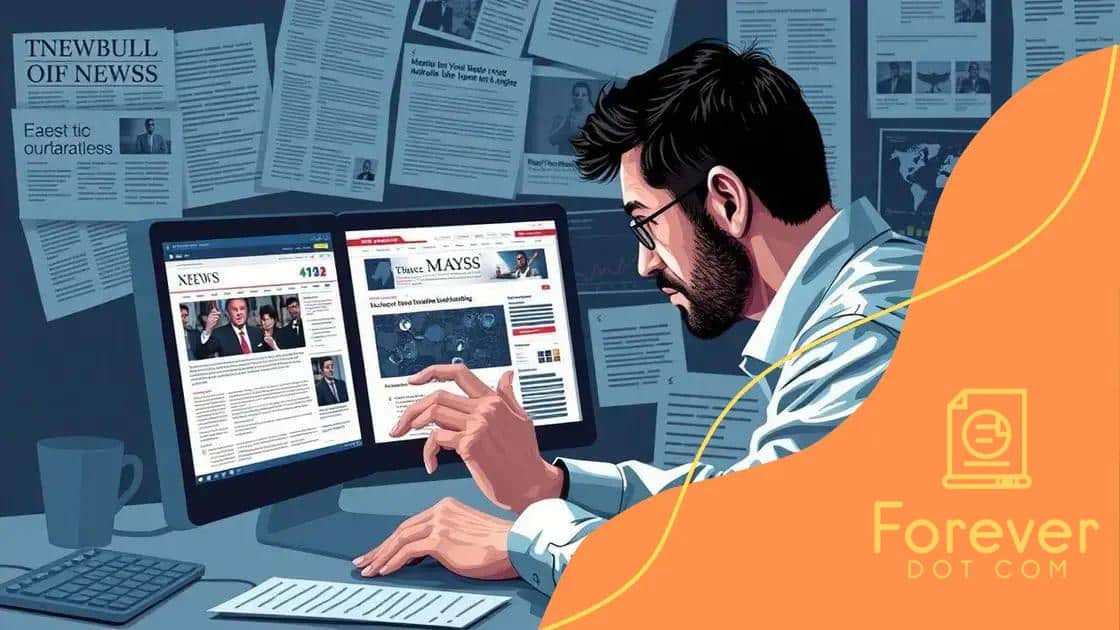Global disinformation control measures: what you need to know

Global disinformation control measures involve strategies such as media literacy education, technology utilization, and community engagement to effectively combat the spread of false information online.
Global disinformation control measures are becoming increasingly essential in our digital age. Have you ever wondered how these strategies protect our society from harmful falsehoods? Let’s dive into their significance.
Understanding disinformation and its impacts
Understanding disinformation is essential in today’s digital world. It spreads rapidly and can have serious impacts on society, politics, and personal beliefs. Disinformation is often misleading or false information shared with the intent to deceive.
The effects of disinformation
Disinformation can alter public opinion and influence elections. When individuals believe false information, it can lead to real-world consequences. This makes it crucial to recognize and combat these harmful narratives.
Common sources of disinformation
- Social media platforms, where information spreads quickly.
- News articles that may not be thoroughly fact-checked.
- Political advertisements that manipulate facts.
- Rumors shared among friends and family.
Each of these sources plays a significant role in how disinformation spreads. Understanding these channels helps us become more informed consumers of information. We can then better scrutinize what we see and hear.
It’s also important to note that disinformation affects not just individuals but entire communities. It can incite fear, division, and anger, leading to social upheaval. As people become polarized, it can become harder to engage in constructive conversations.
With the rise of digital media, the need to combat disinformation has never been greater. Educating ourselves and others about it empowers us to take action against falsehoods.
Key strategies for disinformation control
Key strategies for controlling disinformation are vital for maintaining the integrity of information we consume. Understanding these strategies can help individuals and organizations identify and counteract false narratives.
Media literacy education
Teaching media literacy is a powerful way to combat disinformation. When people learn to critically evaluate sources, they can better discern between fact and fiction. By focusing on skills such as fact-checking and source evaluation, we empower individuals.
- Promote awareness of unreliable sources.
- Encourage investigation of the origin of information.
- Teach the difference between opinion and fact.
- Foster a questioning attitude towards online content.
These skills allow individuals to question what they see online. As a result, they are less likely to fall for false claims.
Collaboration between platforms
Social media platforms play a crucial role in disinformation control. When these platforms collaborate with fact-checkers, they can better identify and address false information.
By implementing policies that flag or remove misleading content, platforms can protect users from harm. Furthermore, creating a community that reports false information strengthens the fight against disinformation.
Investing in technology that detects patterns of misinformation enables platforms to act swiftly. This proactive approach can significantly reduce the spread of harmful content.
Furthermore, encouraging users to verify information before sharing it can slow down the spread of disinformation. Simple reminders to check facts can create a healthier information ecosystem.
The role of technology in combating falsehoods

The role of technology in combating falsehoods is becoming increasingly significant in the digital age. Advanced technologies play a critical role in detecting and addressing misinformation before it spreads widely.
Automated fact-checking
Automated fact-checking tools use algorithms to analyze data and verify claims in real-time. These tools can scan articles and social media posts, flagging potential falsehoods. By doing so, they provide immediate feedback to users about the accuracy of the content they encounter.
- Utilize AI to compare claims against trusted databases.
- Deploy machine learning to improve accuracy over time.
- Integrate user-friendly interfaces for quick access.
- Encourage collaboration with fact-checking organizations.
With these tools, individuals can receive alerts and warnings, leading to a more informed public.
Social media algorithms
Social media platforms use algorithms to determine what content is shown to users. By adjusting these algorithms, platforms can prioritize reliable sources and limit the spread of disinformation.
This involves analyzing user engagement and content credibility to filter out misleading posts. Changes in algorithms can significantly reduce the visibility of false information, creating a more trustworthy online environment.
Moreover, developing technologies that analyze patterns in misinformation help to understand how falsehoods proliferate. Recognizing trends enables stronger measures to combat the root causes of disinformation.
Case studies of successful measures
Case studies of successful measures provide valuable insights into how communities and organizations have effectively tackled disinformation. By examining these examples, we can learn what strategies worked well and how they can be applied elsewhere.
Example: The Malaysian Election
In the 2018 Malaysian general election, social media was flooded with false information. The government and various organizations launched an initiative to combat this. They partnered with fact-checkers and engaged the community in media literacy campaigns. These efforts led to a decline in the spread of false information, showcasing the power of collaboration.
- Utilized social media campaigns to educate citizens.
- Worked with local influencers to spread accurate information.
- Conducted workshops on identifying false news.
- Provided real-time fact-checking during the elections.
This multi-pronged approach greatly improved public awareness and trust in the media.
Example: Finland’s Education System
Finland has been praised for its effective approach to media literacy education. Schools incorporate lessons on critical thinking and media evaluation into their curricula. As a result, students are more inclined to question the information they encounter.
Through interactive lessons and practical exercises, students learn to identify misleading information and the importance of sourcing. This proactive stance toward education not only prepares them to handle disinformation but also helps create informed citizens.
In addition, Finland’s comprehensive approach includes engagement with parents and communities, fostering a culture of skepticism towards unreliable sources. When the public understands the impact of disinformation, they become part of the solution.
Challenges in enforcing disinformation control
Challenges in enforcing disinformation control can significantly hinder efforts to maintain a truthful online environment. As disinformation spreads rapidly, identifying and addressing it becomes increasingly complex.
Identifying sources of disinformation
One major challenge is pinpointing where false information originates. Many times, disinformation is shared anonymously or comes from unofficial sources. This obscurity can make it hard for authorities to act against the perpetrators.
- Fake accounts and bots generate misinformation quickly.
- Some sources disguise their true identity to avoid detection.
- Identifying the networks behind false information is labor-intensive.
- The dynamic nature of the internet allows information to evolve rapidly.
With these obstacles, it becomes difficult to hold individuals or organizations accountable.
Balancing free speech and control
Another significant issue is finding a balance between controlling disinformation and protecting free speech. While it is important to prevent the spread of false information, the measures taken must not silence legitimate opinions and expressions. Striking this balance can lead to controversies about what constitutes censorship.
Policies that aim to control disinformation must be carefully designed to ensure they are fair and just. Implementing transparent guidelines helps the public understand the limits of acceptable speech and allows for constructive dialogue.
Furthermore, the rapid advancement of technology poses ongoing challenges. New methods of spreading disinformation, such as deepfakes and sophisticated bots, require constant adaptation and innovation in response strategies. Keeping up with these technologies can strain resources and expertise.
FAQ – Frequently Asked Questions about Global Disinformation Control Measures
What are disinformation control measures?
Disinformation control measures are strategies and techniques used to identify, combat, and prevent the spread of false information, especially online.
How can I recognize disinformation?
You can recognize disinformation by verifying sources, checking facts, and being skeptical of sensational headlines or claims without evidence.
Why is media literacy important?
Media literacy is important because it helps individuals critically evaluate information, enabling them to distinguish between accurate news and misleading content.
What role does technology play in fighting disinformation?
Technology plays a crucial role by providing tools for fact-checking, analyzing data trends, and filtering out misleading content on social media platforms.






